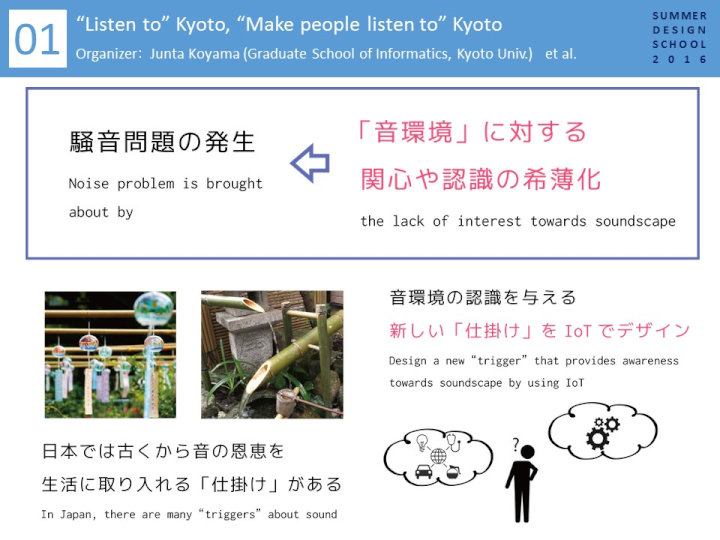You don't need technical experience about electronics.
Let us listen to “Kyoto” and think about a “trigger” that makes people listen to “Kyoto” together!
| Name | Organization | Specialty |
|---|---|---|
| Junta Koyama | Department of Social Informatics, Graduate School of Informatics, Kyoto University (Kyoto University Design School) | Artificial Intelligence, Informatics |
| Ryuhei Kishimoto | Undergraduate School of Informatics and Mathematical Science, Faculty of Engineering, Kyoto University | Informatics |
| Tomoaki Itaba | Department of Social Informatics, Graduate School of Informatics, Kyoto University (Kyoto University Design School) | Non-verbal Communication, Fubeneki |
| Yun Bumjin | Graduate School of Management, Kyoto University | Service |
Nowadays, the number of international tourists has been increasing in the city that represents Japan, Kyoto. There are a lot of Japanese old charms such as temples and shrines in Kyoto. It does not mean visible landscape but also “soundscape” included
in such rich environment that represents its beauty. However, noise problem by international tourists in tourist sites has become more serious recently. It is not a basic problem but has brought by their lack of interest towards soundscape. On
the other hand, many traces about soundscape by ancient people such as “shishiodoshi” or stone garden that are used for introducing the beauty of sound and sound as a “sign” into their daily lives can be observed in Japan.
In “soundscape” theory that is to re-recognize the relationship between environment and human beings by using sound aspect, some “static” and “explicit" design(e.g. a promenade for listening to stream of the river) have been developed. However,
“static" design costs much if we customize it according to environment and human beings. And also explicit design is useful for making people aware of soundscape but we still have had some question about how we can recognize soundscape unconsciously
as an essential problem.
In this theme, we try to design a new attractive “triggers” that provides awareness towards sound environment in Kyoto for people visiting Kyoto by using Internet of Things(IoT) that has been trend today with referencing the wisdom of ancient
people. We can easily develop customizable services to dynamic changes of environment and human beings because IoT devices are reusable. Moreover, IoT is suitable for developing inexplicit “triggers” that assesses situation by sensing and returns
actions in the background level. Therefore, IoT has a high affinity to soundscape design.
In this theme, we first try to acquire “consciousness and understanding about our surround soundscape and its way”. Also, we try to acquire “literacy about IoT application” that is how we can address problems getting from our fieldwork by using IoT technology through prototyping.
- Soundscape Soundscape is a concept to re-recognize environments in terms of invisible sound, proposed by a musician, Murray Schafer in the 1960’s. In this theme, we tackle desining soundscape in Kyoto by using concepts and methods used in Soundscape theory.
- Information Design
- Human Interface
- Fieldwork In this theme, we go to fieldwork inside Kyoto City, find problems about sound environment and get insights from previous sound environment design.
- Soundmap Soundmap is a method to describe sound environment that we heard as a spatial map. In this theme, we use soundmap for problem finding.
- Prototyping We use an educational IoT kit, called MESH(http://meshprj.com/en/) for prototyping. We can realize our idea by connecting block-shaped tags on App without technical knowledge about electronics basically on MESH.
- Have a basic lecture about Soundscape and IoT. (KRP)
- Go to a fieldwork for making sound maps (Kyoto city, undecided)
- Go to a fieldwork for case studies (Kyoto city, undecided)
- Share each sound map, extract problems and structualize them (KRP)
- Share insights from case studies, abstract and itemize them (KRP)
- Ideation about IoT solution for problems by brainstorming (KRP)
- Select an idea for prototyping from ideas from brainstorming (KRP)
- Substantiate the idea for prototyping in terms of function and interface (KRP)
- Make a prototype of the idea, divided into 2 teams; function and interface (KRP)
- Make a prototype of the idea, divided into 2 teams; function and interface (KRP)
- Make a prototype of the idea, divided into 2 teams; function and interface (KRP)
- Prepare for presentation (KRP)
- Present workshop results (KRP)
